Overview

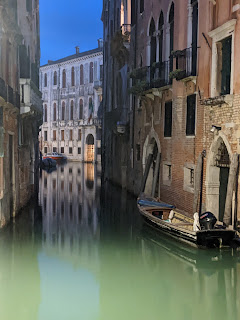


Random photos around Venice: at night, in the Castello quartiere, and an interesting cat.
12 Tips
(1) Where to stay if primarily focused on Biennale?
- We would suggest Castello. It’s within a comfortable walking distance of the two principal venues (Arsenale and Giardini).
- There are six districts or quarters of Venice. The Castello is one of these districts.
- We felt that a good chunk of the Castello district still felt authentic, more spacious, and less touristy.
- For us, as far away from the hordes of tourists, the better. I know, we are tourists too.
- If you stay elsewhere in Venice, you can also walk or you can take a boat to get to the Biennale main venues.
(2) How much time to spend visiting the Biennale?
- It depends on you and how much you want to take in.
- You can think of the Biennale as three parts Arsenale, Giardini, and Collateral Events.
- Arsenale and Giardini are near each other.
- Collateral Events are spread out across the city.
- Suggested 1-day tour
- Arsenale in the morning and Giardini in the afternoon, or vice versa.
- Assuming you bought a basic ticket, you have one entry into Arsenale and one into Giardini.
- This is a busy day of art!
- You could eat inside one of the venues or do lunch outside between the venues.
- Suggested 2-day tour
- Buy one basic ticket, which gives you one entrance into the Arsenale and one into Giardini.
- Do the Arsenale one full day and Giardini the second full day, or vice versa.
- Assuming you bought a basic ticket, this would mean getting lunch inside a venue and not leaving if you wanted to spend the whole day in one venue.
- Variation: do this tour and then leave 1-2 days for finding all the other Biennale Collateral Events spread out across Venice, which are generally free to enter.
- Suggested 3+ day tour:
- Buy two basic tickets so you have two entries into each venue (Arsenale and Giardini).
- Do half days (or as much as you can take) at the Arsenale and Giardini as you want, spread out over several days.
- Between visits to Arsenale and Giardini, go find the numerous other Collateral Events spread out across Venice.
- This is more or less what we ended up doing. We like eating a lunch at a trattoria or osteria outside of the Arsenale and Giardini.
(3) What’s the Arsenale venue like?
- The Arsenale is a complex of shipyards and armories in Venice of which one part is an important venue of the Biennale.
- The Arsenale was once the largest industrial complex in Europe before the Industrial Revolution.
- The Arsenale is located at the eastern side of Venice, 30 minutes walking distance from Piazza San Marco.
- The Arsenale complex is in the Castello district.
- The Arsenale venue is shaped like a big letter V. You typically start at one size of the V (Ramo del la Tana) and exit the other size (just after the structure called the Gaggiandre). Following this path, you exit into the peaceful Giardino delle Vergini, which also has things to see that are connected to the Biennale. You could also start at the Giardino delle Vergini and go in reverse.
- The Arsenale is a series of spaces – large and small – featuring artwork, video, and installations of all types.
(4) What’s the Giardini venue like?
- Giardini or "gardens" is a large garden area dotted with pavilions.
- Each pavilion is tied to a country that features one or more artists.
- It’s pleasant to walk around the gardens and discover what’s inside each pavilion. Great for kids and adults.
- Each country pavilion is a place you enter, walk around, and enjoy what’s presented. Some pavilions are open, some closed, some light, some dark, some highly constructed and other deconstructed.
- There are two pavilions that are not countries:
- The city of Venice has its own pavilion in Giardini.
- Also, the Center Pavilion is huge pavilion / exhibition space featuring a lot of artists. In fact, the Center Pavilion alone could easily take up to 3+ hours to see. The Center Pavilion was the nucleus of the first Biennale back in 1895.
- International / country pavilions. Some are exceptional this year like: USA – Simone Leigh: Sovereignty, Greece – Oedipus in Search of Colonus, and Republic of Korea - Gyre.
- Some international pavilions are in the Arsenale or spread our in the Collateral Events. For example, Italy and China, and many others country pavilions are in the Arsenale and not Giardini.
- I guess we have Napoleon to thank for the Giardini della Biennale? From the Biennale site: “The traditional site of La Biennale Art Exhibitions since the first edition in 1895, the Giardini rise to the eastern edge of Venice and were made by Napoleon at the beginning of the nineteenth century. It was the success of the first editions (more than 200,000 visitors in 1895, more than 300,000 in 1899) to trigger the building of foreign pavilions since 1907, which were added to the already built Central Pavilion. The Giardini now host 29 pavilions of foreign countries, some of them designed by famous architects such as Josef Hoffmann's Austria Pavilion, Gerrit Thomas Rietveld's Dutch pavilion or the Finnish pavilion, a pre-fabricated with a trapezoidal plan designed by Alvar Aalto.”
- The name of this year’s exhibition is The Milk of Dreams (“Il latte dei sogni” in Italian) and comes from the title of a book by Leonora Carrington (1917–2011).
- The book combines Surrealist painter Leonora Carringon's fantastical writing and illustrations for children.
- The curator Cecilia Alemani states “The Exhibition The Milk of Dreams takes Leonora Carrington’s otherworldly creatures, along with other figures of transformation, as companions on an imaginary journey through the metamorphoses of bodies and definitions of the human.”
- Within the larger exhibition there smaller “sub”-exhibitions that are called Historical Capsules:
- “Technologies of Enchantment” (Center Pavilion, Giardini). Beautiful works featuring light in one form or another.
- “The Witches Cradle” (Center Pavilion, Giardini). Featuring a Carrington painting, “Portrait of the Late Mrs Partridge” (1947), this capsule is about self-metamorphosis.
- “Corps Orbite” (Center Pavilion, Giardini) - we missed this one because we ran out of time!
- “Seduction of Cyborg” (Arsenale). Artists as cyborgs. This was fun to explore.
- “A leaf a gourd a shell a net a bag a sling a sack a bottle a pot a box a container” (Arsenale). This title uses Ursula K. Le Guin’s metaphor that first cultural inventions are containers.
- These smaller exhibitions were all very well done and worth seeing.
- The Biennale Arte 2022 runs from April 23, 2022 to November 27, 2022.
- Hours are:
- April 23 – September 25, 11 am - 7 pm
- September 27 – November 27, 10 am - 6 pm
- Arsenale open until 8 pm on Fridays and Saturdays, until 25 September (last admission: 7:45 pm)
- Closed on Mondays (except Monday 27 June, 25 July, 15 August, 5 September, 19 September, 31 October, 21 November).
- Basic ticket is for one visit for Arsenale and one visit for Giardini. Stop. No re-entry.
- Basic tickets “guarantee admission to both venues of the Exhibition, one time for each venue, on the same day or on different days. The days you visit each venue do not necessarily need to be consecutive. The ticket does not allow you to enter and leave the venue more than once.”
- Once you are in the venue (Arsenale or Giardini), you are in. Once you leave, your ticket for that venue is invalidated.
- Most of the Collateral Events have free admission, except for some that might require an admission ticket sold at the venue.
- If you are press, you have more options. See the FAQ.
- Our experience: We misread how the basic ticket worked and thought that it would allow us multiple entries to each venue. When we found out otherwise, we bought second tickets because we weren't done. When we went to buy our second ticket, a person at the ticket desk said there was a weekly option. As far as we can tell that only applies to press. So, in the end, we bought two tickets and followed the 3+ day itinerary given above.
(8) How can I make the most out of my visit when I’m there?
- Buy a book/guide before hand or at the on-site bookstore.
- Just wander and read the information next to the works, which is generally pretty good.
- Make use of guides/docents in key rooms. Docents were places in many rooms of the Arsenale. They know about the works and good to talk to. They speak English.
- Use the Bloomberg Guide (iOS) (Android).
- It's chock full of information, but … 1) it’s clumsy to use, and 2) the app kept resetting for me every so often so that you had to spend a minute entering and getting back to where you left off. Also – a pet peeve - you can’t listen off the phone, say on your computer. The experience is locked just to your phone.
- The Biennale website
- Make sure you are in the /art/ subsection for the right year /2022/.
- When searching it helps to be specific, for example, “greece 2022 pavilion”.
(9) What can I do before coming?
- Download the Bloomberg Guide and poke around a bit to see what might be interesting.
- Use the https://www.labiennale.org/en site.
- Be sure to go into Art part of site: https://www.labiennale.org/en/art/2022
- When searching, use terms with country and date, e.g., “Denmark 2022”.
- Download the Biennale brochure to study the layout of Arsenale and the Giardini. It will help orient you.
- Also, look at the layout of Giardini on a map.
(10) Any other observations about the Biennale?
- There are a lot of videos in the Biennale. Some good, some not. You have to spend time to watch them to “get” it.
- Overall, videos are much more compelling than they were say 10 years ago. The quality has gone up.
- Some videos run 15 – 20 minutes long. It’s a commitment to give yourself over when all this other art is waiting. You can’t just poke your head in for 10 seconds and then leave. (Well, you could, but then what's the point?)
- Allow time to pass through the spaces multiple times if you can. For example, in the Arsenale, we walked back and forth through the space a few times and it was very pleasurable, especially about one hour before closing when there is hardly anybody there.
- The Biennale demands several days spread out. That’s really the point of this post.
- If you have limited amount of time, give yourself permission not to see everything. Favor quality over quantity.
- A long line waiting to see something doesn’t mean it’s good.
- Rather, it often means there is limited space, was an artist decision, or limited capacity of equipment (like VR sets).
- Where did we see a line? Greece, Chilean, Italian, and Uzbekistan pavilions in the Arsenale.
- Worth the wait: Italian (25 minutes), Greece (2 minutes)
- Not enough time in general to see and experience the Biennale and Venice at a slower pace. We were there for 4 days and felt it wasn’t enough.
- Not enough time searching out all the Collateral Events. Half the fun is trying to find these events because the journey takes you to parts of the city you wouldn’t otherwise see, and the spaces are interesting.
- Next time, we would try to load more of our Biennale time during weekdays.
- Not spending enough time upfront to see what might be interesting. (Okay, there is always the balance between let me just experience verses study up on it beforehand.)
- We didn’t book restaurants ahead of time. We were surprised how many of our first choices were booked on Friday and Saturday for lunch and dinner.
(12) Any tips on restaurants?
- Book ahead to be sure you get what you want.
- We felt that while we ate well in Venice, the price/quality ratio was higher than in other parts of Italy. (Lower ratio is better.)
- To get a fine dining experience, you’ll be paying a bit more. There are many places serving chicchetti that are informal and approaching a good (lower) price/quality ratio. Some of these places you can eat standing for a quick bite.
- Here’s what we tried and liked over the years of visiting Venice - in no particular order:
- Osteria da Pampo
- Ristorante Gibran (Caffè Libano)
- Antica Osteria da Gino
- Osteria Al Portego
- Ai 4 Feri Storti Osteria
- Sullaluna libreria & bistro
- Osteria a la Scuela
- Trattoria d’a Marisa
- Osterai Mocenigo
- La Bitta
- Trattoria Anzolo Raffaele
- Trattoria da Jonny


Left: Restaurants we've tried over the years in Venice. Right: The Bloomberg application for the Biennale showing venue locations. Most are collateral events.
Photos from the Biennale Arte 2022
Arsenale
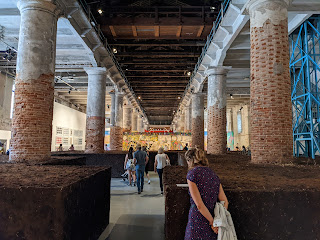
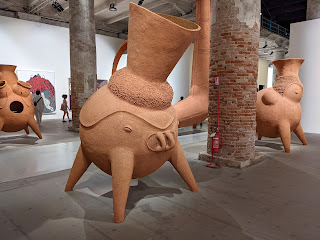
Left to right: Delcy Morelos - Columbia; Gabriel Chaile - Argentina; Emma Talbot - UK.

Works by Felipe Baeza - Mexico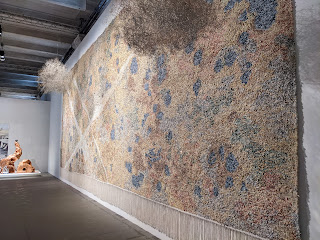

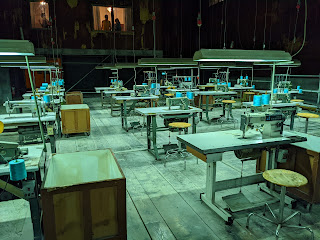
Left: Igshaan Adams - South Africa; Center and right: Italy Pavilion - History of Night and Destiny of Comets.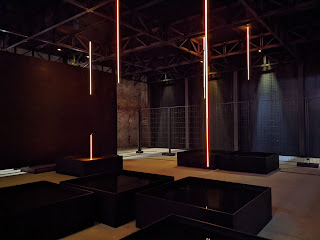
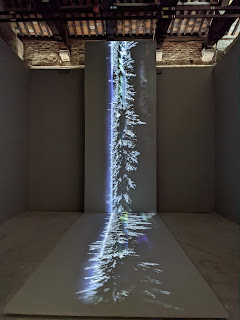

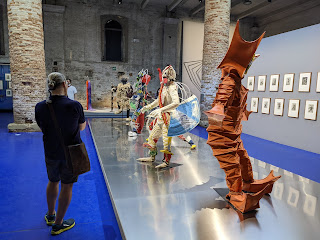
Left to right: Malta Pavilion - Diplomazija Astuta; Iceland Pavilion - Perpetual Motion; Rebecca Horn - Germany - Seduction of the Cyborg; Lavinia Schulz and Walter Holdt - Germany - Seduction of the Cyborg.

Left to right: Niki de Saint Phalle - France; Ruth Asawa - USA; Uzbekistan (Republic of) - Dixit Algorizmi Garden of Knowledge.
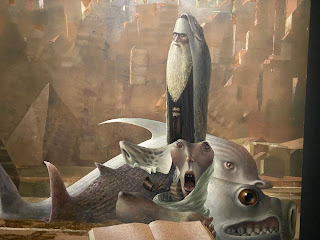
%20-%20Into%20the%20Light.jpg)
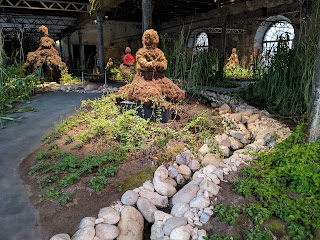
Left to right: Slovenia Pavilion - Without a Master - Marko Jakše; South Africa (Republic of) - Into the Light; Precious Okoyomon - The Milk of Dreams, To See the Earth before the End of the World.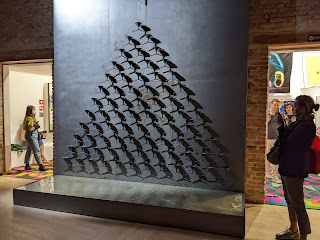
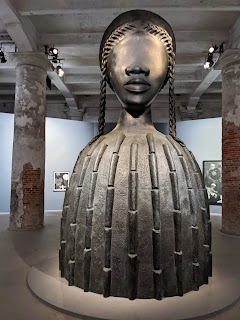
Left to right: Tau Lewis - Canada; Turkey Pavilion - Once upon a time - Füsun Onur; Ukraine - The Fountain of Exhaustion. Acqua alta - Pavlo Makov; Simone Leigh - Brick House;
Giardini





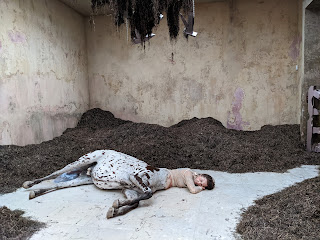


Left to right: Denmark - We Walked the Earth; Greece - Oedipus in Search of Colonus (VR); Venice Pavilion - Laurel; Brazil - com o coração saindo pela boca with the heart coming out of the mouth - Jonathas de Andrade.%20-%20Gyre%201.jpg)
%20-%20Gyre%202.jpg)
%20-%20Gyre%203.jpg)
%20-%20Gyre%204.jpg)
Korea (Republic Of) - Gyre




Left to right: Switzerland - The Concert; USA Pavilion - Simone Leigh, inside and outside

Left to right: Israel – Queendom; Merikokeb Berhanu - Ethiopia - Center Pavilion




.JPG)
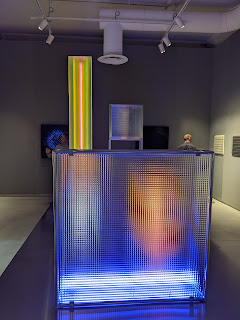
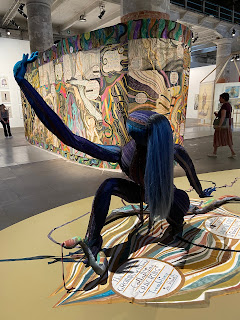
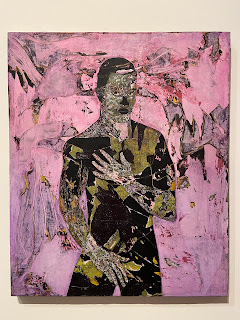
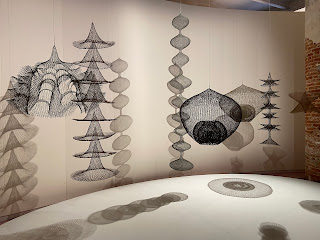
%20-%20Dixit%20Algorizmi%20Garden%20of%20Knowledge.JPG)
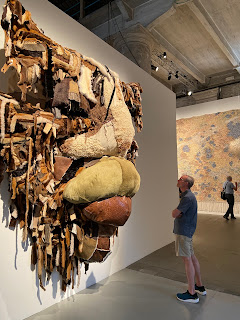



No comments:
Post a Comment
All comments are moderated. If your comment doesn't appear right away, it was likely accepted. Check back in a day if you asked a question.